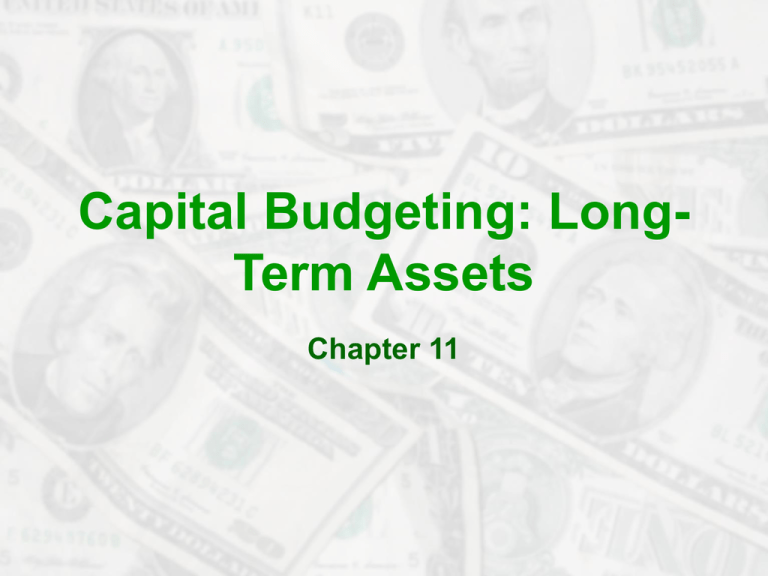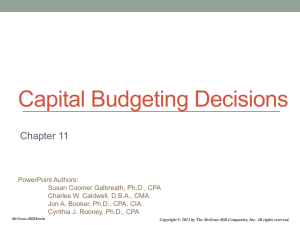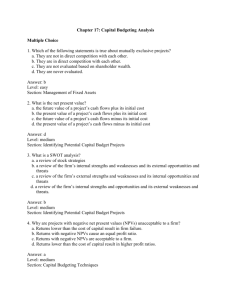Capital Budgeting: Long
advertisement

Capital Budgeting: LongTerm Assets Chapter 11 Capital Assets • Chapters 3 and 4 discussed the cost of capacity resources that organizations purchase and use for years to make goods and provide services • Capital assets create these capacity-related costs • Cost commitments associated with long-term assets create risk for an organization: Need to Control Capital Assets Long-term commitment creates the potential for • Excess capacity that creates excess costs • Scarce capacity that creates lost opportunities Large amount of money committed to the acquisition of capital assets Long-term nature of capital assets creates technological risk • Capital budgeting is a systematic approach to evaluating an investment in a capital asset Investment and Return • Cost-benefit analysis • Investment is the monetary value of the assets the organization gives up to acquire a long-term asset • Return is the increased future cash inflows attributable to the long-term asset capital budgeting focuses on whether the expected increased cash flows (return) will justify the investment in the long-term asset Time Value of Money • Time value of money (TVM) is a central concept in capital budgeting • Because money can earn a return: Its value depends on when it is received Using money has a cost • In making investment decisions, the problem is that investment cash is paid out now, but the cash return is received in the future Time Value of Money (2 of 2) • Because money has a time-dated value, the critical idea underlying capital budgeting is: Amounts of money spent or received at different periods of time must be converted into their value on a common date in order to be compared Some Standard Notation Abbr. n FV PV a r Meaning Number of periods considered in the investment analysis; common period lengths are a month, a quarter, or a year Future value, or ending value, of the investment n periods from now Present value, or the value at the current moment in time, of an amount to be received n periods from now Annuity, or equal amount, received or paid at the end of each period for n periods Rate of return required, or expected, from an investment opportunity; the rate of interest earned on an investment Future Value • Because money has time value, it is better to have money now than in the future • The future value (FV) is the amount that today’s investment will be after earning a stated periodic rate of return for a stated number of periods • For one period: FV=PV x (1+r) FV with Multiple Periods • An initial amount of $1.00 accumulates to $1.2763 over five years if the annual rate of return is 5%: Year 0 Year 1 Year 2 Year 3 Year 4 Year 5 $1.0000 $1.0500 $1.1025 $1.1576 $1.2155 $1.2763 • This calculation assumes the following: Interest earned stays invested until the end of year Compound effect of interest Computing Future Values For Multiple Periods (1 of 2) • The formula for a future value is FV=PV x (1+r)n • Calculator methods (using 5 years at 5%) Multiply $1.00 by 1.05 five times If your calculator computes exponents directly, you may compute $1.00x(1.05)5 Financial calculators have TVM functions that allow you to compute FV Computing Future Values For Multiple Periods (2 of 2) • Table Method Tables that provide the factors needed to compute a future value for different numbers of periods and rates of return are available Find where the column (r) intersects with the row (n). Multiply this factor by the amount of the initial investment to find the future value • Spreadsheet Method Every computer spreadsheet program can compute future values and all other financial calculations described in this chapter Choosing a Common Date • An investment’s cash flows must be converted to their equivalent value at some common date in order to make meaningful comparisons between the project’s cash inflows and outflows • The conventional choice is the point when the investment is undertaken Analysts call this time zero, or period zero • Capital budgeting analysis converts all future cash flows to their equivalent value at time zero Present Value • Analysts call a future cash flow’s value at time zero its present value • The process of computing present value is called discounting • The FV formula can be rearranged to compute the present value: FV = PV x (1 + r)n PV = FV/(1 + r)n or PV = FV x (1 + r)-n Decay of a Present Value • Invested amounts grow at a compound rate over time • A fixed amount of cash to be received at some future time becomes less valuable as: Interest rates increase The time period before receipt of the cash increases • Arbitrarily high interest rates will result in projects (especially long-term ones) being inappropriately turned down Annuities • Not all investments have cash outlays at time zero and provide a single benefit at some future point • Most investments provide a series, or stream, of benefits over a specified future period • An investment that promises a constant amount each period over n periods is called an n-period annuity PV of an Annuity • Suppose you have won a $20 million lottery prize that pays $1 million a year for 20 years You are interested in selling this annuity to raise cash to purchase a business What is the value of this annuity today, if the current rate of interest is 7%? • Using a table we can compute the present value of the lottery annuity as follows: PV = a x annuity present value factor7%, 20 periods = $1,000,000 x 10.594 = $10,594,000 Computing the Required Annuity • Computing the annuity value that a current investment will generate For example, if you agreed to repay a loan with equal periodic payments, then you are selling the lender an annuity in exchange for the face value of the loan • The factor required to compute the amount of the annuity to repay a present value is simply the inverse of the present value factor for an annuity: Annuity factor = 1 / PV factor Cost of Capital • The cost of capital is the interest rate used for discounting future cash flows Also known as the risk-adjusted discount rate • The cost of capital is the return the organization must earn on its investment to meet its investors’ return requirements • The organization’s cost of capital reflects: The amount and cost of debt and equity in its financial structure The financial market’s perception of the financial risk of the organization’s activities Capital Budgeting • Capital budgeting is the collection of tools that planners use to evaluate the desirability of acquiring long-term assets • Six approaches are discussed here: Payback Accounting rate of return Net present value Internal rate of return Profitability index EVA criterion Shirley’s Doughnut Hole • To show how each of these methods works and alternative perspectives, we apply each to Shirley’s Doughnut Hole as it considers the purchase of a new automatic doughnut cooker: Cost: $70,000 Life: five years Benefit: expanded capacity and reduced operating costs would increase Shirley’s profits by $20,000 per year with a cost of capital is 10% The new cooker would be sold for $10,000 at the end of five years Payback Criterion • The payback period is the number of periods needed to recover a project’s initial investment Shirley’s initial investment of $70,000 is recovered midway between years 3 and 4 (3.5 years) • Many people consider the payback period to be a measure of the project’s risk The organization has unrecovered investment during the payback period The longer the payback period, the higher the risk Compare a project’s payback period with a target that reflects the organization’s acceptable level of risk Problems with Payback • The payback criterion has two problems: Ignores the time value of money Ignores the cash outflows that occur after the initial investment and the cash inflows that occur after the payback period so focus is on short-run performance instead of overall profitability • Despite these limitations, some surveys show that the payback calculation is the most used approach by organizations for capital budgeting Accounting Rate of Return • Accounting rate of return - average accounting income divided by the average level of investment Used to approximate the return on investment • The increased annual income that Shirley’s will report related to the new cooker will be $8000 $20,000 - $12,000 of depreciation The average income will equal the annual income since the annual income is equal each year • The average investment is $40,000 = [($70,000 + 10,000) / 2] Accounting Rate of Return (2 of 2) • The accounting rate of return for the cooker investment is computed as: $8,000 / $40,000 = 20% • If the accounting rate of return exceeds the target rate of return, then the project is acceptable • Drawback: does not consider the timing of cash flows • An improvement over the payback method in that it considers cash flows in all periods Net Present Value • The net present value (NPV) is the sum of the present values of a project’s cash flows • The steps used to compute an investment’s net present value are as follows: Step 1: Choose the appropriate period length to evaluate the investment proposal • The period length depends on the periodicity of the investment’s cash flows • The most common period used in practice is one year » Analysts also use quarterly and semiannual periods Net Present Value Step 2: Identify the organization’s cost of capital, and convert it to an appropriate rate of return for the period length chosen in step 1 Step 3: Identify the incremental cash flow in each period of the project’s life Step 4: Compute the present value of each period’s cash flow using the organization’s cost of capital for the discount rate Step 5: Sum the present values of all the periodic cash inflows and outflows to determine the investment project’s net present value Step 6: If the project’s net present value is positive, the project is acceptable from an economic perspective Net Present Value • • • • To determine the NPV of Shirley’s investment: Step 1: The period length is one year Step 2: Shirley’s cost of capital is 10% per year Step 3: The incremental cash flows are: $70,000 outflow immediately $20,000 inflow at the end of each year for five years $10,000 inflow from salvage at the end of five years • It is useful to organize the cash flows associated with a project on a time line to help identify and consider all the project’s cash flows systematically Net Present Value • Step 4: The present value of the cash flows when the organization’s cost of capital is 10% are: For a five-year annuity of $20,000, PV = $75,816 For the $10,000 salvage in five years, PV = $6,209 • Step 5: To sum the present values of all the periodic cash flows and determine NPV The PV of the cash inflows is $82,025 Because the investment of $70,000 takes place at time zero, the PV of the total outflows is $(70,000) The NPV of this investment project is $12,025 • Step 6: Because the NPV is positive, Shirley’s should purchase the cooker It is economically desirable Internal Rate of Return • The internal rate of return (IRR) is the actual rate of return expected from an investment • The IRR is the discount rate that makes the investment’s net present value equal to zero If an investment’s NPV is positive, then its IRR exceeds its cost of capital If an investment’s NPV is negative, then it’s IRR is less than its cost of capital • By trial and error, or the use of a financial calculator or spreadsheet software, we find that the IRR in Shirley’s is 16.14% Because a 16.14% IRR > 10% cost of capital, the project is desirable Internal Rate of Return • IRR has some disadvantages: It assumes that a project’s intermediate cash flows can be reinvested at the project’s IRR It can create ambiguous results, particularly: • When evaluating competing projects in situations where capital shortages prevent the organization from investing in all positive NPV projects • When projects require significant outflows at different times during their lives • Because a project’s NPV summarizes all its financial elements, using the IRR criterion is unnecessary when preparing capital budget Survey Results: % Rating the Capital Budgeting Tool as Extremely Important NPV 27% Accounting Rate of Return 13% Payback 32% IRR 28% Profitability Index • The profitability index is a variation of the net present value method • It is used to make comparisons of mutually exclusive projects with different sizes and is computed by dividing the present value of the cash inflows by the present value of the cash outflows • A profitability index of 1 or greater is required for the project to be acceptable Profitability Index • Shirley’s Doughnut Hole example: the present value of the cash inflows was $82,025 and the present value of the cash outflows was $70,000 • The profitability index for that project is 1.17 = $82,025/$70,000 • It is possible for project A to have a higher profitability index while project B has a higher NPV Economic Value Added • Economic value added (EVA) criterion - new way to evaluate organization performance EVA = adjusted accounting income – (cost of capital * investment level) • Accounting income is adjusted for what the EVA proponents consider to be GAAP’s conservative bias Common adjustments: capitalizing and amortizing research and development and significant product launch costs, adjusting for the LIFO effect on inventory valuation, and eliminating the effect of deferred income taxes Economic Value Added • The formula for economic value added is directly related to the net present value criterion The major difference between the two is that EVA begins with accounting income, which includes various accruals and allocations rather than net cash flow as does NPV This is why EVA is more suited to evaluating an ongoing investment than a new investment opportunity Effect of Taxes • In practice, capital budgeting must consider the tax effects of potential investments • In general, the effect of taxes is twofold: Organizations must pay taxes on any net benefits provided by an investment Organizations can use the depreciation associated with a capital investment to reduce income and offset some of their taxes Effect of Taxes • Assume Shirley’s income taxed rate is 40% • Assume that the relevant tax law requires Shirley’s to claim straight-line depreciation as a tax-deductible expense (Historical cost less salvage value) / useful life • Convert all pretax cash flows to after-tax cash flows: Using straight-line depreciation, Shirley’s Doughnut Hole will claim $12,000 depreciation each year Taxable income of $8,000 will result in Shirley’s paying $3,200 in income taxes each year The annual after-tax cash flow will be $16,800 Effect of Taxes • The investment provides two after-tax benefits: Five-year annuity of $16,800 Lump-sum payment of $10,000 at the end of five years • Because book value after five years is $10,000, there is no gain in selling it for $10,000 and, therefore, no tax • The present value of the five-year annuity of $16,800 discounted at 10% is $63,685 • The present value of the lump-sum payment of $10,000 is $6,209 • The net present value of this investment project is $(106) = ($63,685 + 6,209 - 70,000) • Because the project’s net present value is negative, it is not economically desirable Effect of Inflation • Inflation is a general increase in the price level • Adjust future cash flow to compare dollars of similar purchasing power Discount future cash flows to the present using an appropriate discount rate to account for the time value of money Discount each cash flow by the appropriate discount rate and the expected inflation rate • If Shirley’s expected inflation of 2.5%, the combined discount rate would be 1.1275% = 1.10 x 1.025 Uncertainty in Cash Flows • Capital budgeting analysis relies on estimates of future cash flows • Estimating future cash flows is an important and difficult task Important because many decisions will be affected by those estimates Difficult because these estimates will reflect circumstances that the organization may not have previously experienced Uncertainty in Cash Flows • Most cash flow estimation is incremental • Many organizations assume that learning will systematically reduce the costs of a new system or process • Cash flows related to sales of a new product are often estimated based on past experiences with similar products • The forecast usually starts with previous experience and makes adjustments High Low Method • Estimate the most likely effect of a decision, such as a cost decrease or a revenue increase, and then estimate the highest and lowest possible values • Constructs a normal distribution with a mean equal to the most likely value estimated and a standard deviation calculated by subtracting the mean from the highest estimated value and dividing the difference by 3 • Only the mean or expected value of the estimate is needed for the net present value model, but by developing a distribution of expected outcomes, the probabilistic statements about the results can be developed Expected Value Method • Identify 4-5 possible outcomes and assign each a probability of occurring, such that the total probabilities assigned equals one • Compute the expected value of the estimate by weighting each estimate by its probability • This estimate is used in the capital budgeting model to project the revenue and cost effects of the investment project Wait and See • In some circumstances, an organization may be able to delay a final decision and undertake a smaller version of the project to gain more information • In real options analysis, the organization purchases an option that allows the option holder to purchase an asset at a specified future point in time at a specified price (a European call option) • The value of the option is determined by the volatility of the future value of the asset What-If & Sensitivity Analysis • Two other approaches to handling uncertainty are what-if and sensitivity analysis In the Shirley’s Doughnut Hole example, Shirley might ask, “What must the cash flows be to make this project unattractive?” • The planner can set up a computer spreadsheet to make changes to the estimates of the decision’s key parameters What-If & Sensitivity Analysis • If the analysis explores the effect of a change in a parameter on an outcome, we call this investigation a what-if analysis For example: “What will my profits be if sales are only 90% of the plan?” • A planner’s investigation of the effect of a change in a parameter on a decision, rather than on an outcome, is called a sensitivity analysis For example: “How low can sales fall before this investment becomes unattractive?” Strategic Considerations • The common benefits associated with acquiring long-term assets (e.g., increased profits) ignore the assets’ strategic benefits, which are of increasing importance • Including strategic benefits in a capital budgeting example is controversial because they can be difficult to estimate Strategic Considerations • Long-term assets usually provide the following strategic benefits: They allow an organization to make goods or deliver a service that competitors cannot They support improving product quality by reducing the potential to make mistakes They help shorten the production cycle time Strategic Considerations • Shirley’s may consider investing in a cooker that senses when a doughnut is cooked and ejects it automatically • The benefits from the automatic cooker can include increased sales and lower operating expenses if the competitors do not have this cooker The automatic cooker can prevent an erosion of sales if Shirley’s competitors also purchase it • Post-Implementation Audits • Revisiting the decision to purchase a long-lived asset is called a post-implementation audit of the capital budgeting decision and provides many valuable insights for decision makers • When estimates are used to support proposals, recognizing the behavioral implications that lie behind them is important Post-Implementation Audits • Many organizations fail to compare the estimates made in the capital budgeting process with the actual results • This is a mistake for three reasons: Post-Implementation Audits • • • By comparing estimates with results, the organizations planners can identify where estimates are wrong and avoid making similar mistakes in the future By assessing the skill of planners, organizations can identify and reward those who are good at making capital budgeting decisions By auditing the results of acquiring long-term assets, companies create an environment in which planners are less tempted to inflate estimates of the cash benefits associated with their projects in order to get them approved Budgeting Other Spending Proposals • Organizations develop spending proposals for discretionary items other than capital expenditures • Such items can provide benefits that will be realized for many periods into the future • Their magnitude suggests that they should be evaluated like capital spending projects when possible Budgeting Other Spending Proposals • The approach to analyzing a discretionary expenditure is identical to that used to decide whether to make a capital investment: Estimate the discounted cash inflows (benefits) and discounted cash outflows (costs) associated with any discretionary spending project Accept the project if the NPV is positive






